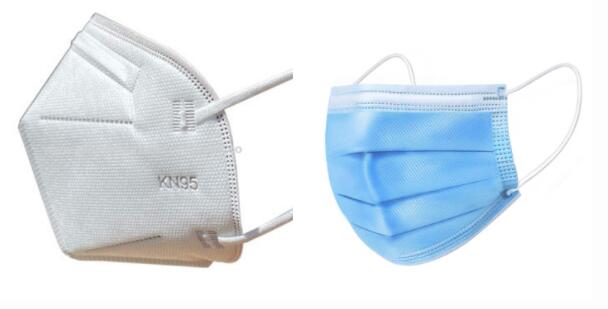Personal safety protection equipment is divided into four parts:
1. Body protection
2. Physical protection
3. Respiratory protection
4. Head and face protection
We mainly talk about the precautions of respiratory protective equipment:


1. The choice of respiratory protective equipment-according to the operator's choice
1. Head and facial features
When choosing a half face mask or full face mask, pay attention to:
1) If the manufacturer or distributor of respiratory protective equipment can provide the user with a suitability test, it can help the user choose a suitable close-fitting mask.
2) Beard or excessively long hair will affect the adhesion between the mask and the face. Users should shave their beards in advance to avoid pinching hair between the mask and facial skin;
3) The facial features of the user should be considered. If the tightness between the face and the mask is affected by scars, sunken temples, very prominent cheekbones, skin folds, nasal deformities, etc., a mask that has nothing to do with facial features should be selected.
2. Comfort
The working environment should be evaluated to determine whether the workers will bear the adverse effects of physical factors (such as high temperature), and choose respiratory protective equipment that can reduce such adverse effects and wear comfortable, such as the choice of air-supply respiratory protective equipment with cooling function.
3. Vision correction
Vision correction glasses should not affect the tightness of the respiratory protective equipment with the face. If the respiratory protective equipment provides structural parts that use corrective lenses, suitable vision corrective lenses should be selected and used in accordance with the requirements of the instruction manual.
4. Physical conditions not suitable for the use of respiratory protective equipment
The advice of an industrial hygienist should be sought. For those who have a history of cardiopulmonary disease, severe psychological stress to small spaces and respiratory load, they should consider their ability to use respiratory protective equipment.
Second, the use of respiratory protective equipment
1. General principles
1) The protective function of any respiratory protective equipment is limited, and users should be made aware of the limitations of the respiratory protective equipment used.
2) When using any kind of respiratory protective equipment, you should carefully read the product instructions and use them strictly as required.
3) Training on the use of respiratory protective equipment should be provided to all users. Relevant workers and other personnel in the workplace where escape-type respiratory protective equipment must be equipped shall receive training on the use of escape-type respiratory protective equipment.
4) Before use, check the integrity of the respiratory protective equipment, the applicability of the filter element, the battery power, the gas storage capacity of the gas cylinder, etc., and the use is allowed after eliminating the phenomenon that does not meet the relevant regulations.
5) Before entering the hazardous environment, wear respiratory protection equipment. For the close-fitting mask, the user should check the air-tightness of the wearing and confirm the tightness with GB/T 18664-2002.
6) Personnel working in hazardous environment should always wear respiratory protective equipment.
7) It is not allowed to use escape-type respiratory protective equipment alone to enter the harmful environment, only to leave it.
8) When you feel uncomfortable symptoms such as peculiar smell, cough, irritation, nausea, etc., you should leave the harmful environment immediately, and check the respiratory protection equipment, and then enter the harmful environment after confirming and troubleshooting; if there is no fault, replace it Effective filter element.
9) If the respiratory protective equipment uses several filter elements at the same time, such as double filter boxes, they should be replaced at the same time.
10) If the new filter element fails quickly in a certain situation, the applicability of the selected filter element should be re-evaluated.
11) Except for general parts, parts of different brands of respiratory protection equipment should not be assembled or used in combination without the approval of the manufacturer of respiratory protection equipment.
3. Inspection and maintenance of respiratory protective equipment
1) The inspection and maintenance should be carried out by trained personnel in accordance with the relevant content and requirements in the instructions for use of respiratory protective equipment. For the content not included in the instructions, the manufacturer or distributor should be consulted.
2) Regular inspection and maintenance of respiratory protective equipment should be done.
3) After SCSA is used, the used or partially used gas cylinder or breathing gas generator should be replaced immediately, and other filter components should be replaced. It is not allowed to exchange air and oxygen cylinders when replacing gas cylinders.
4) Air cylinders or oxygen cylinders should be tested regularly in institutions with corresponding pressure vessel testing qualifications in accordance with relevant national regulations.
5) Special lubricants should be used to lubricate high-pressure air or oxygen equipment.
6) Users are not allowed to refill the filter-type respiratory protective equipment canister or the adsorption filter material in the canister, nor are they allowed to take any method to extend the service life of the filter element that has failed.
4. Cleaning and disinfection of respiratory protective equipment
1) Respiratory protective equipment for personal use should be cleaned and disinfected regularly, and non-personal use should be cleaned and disinfected after each use.
2) It is not allowed to clean the filter element. For filter-type respiratory protective equipment with replaceable filter elements, the filter element should be removed before cleaning.
3) When cleaning the mask, disassemble the relevant parts according to the requirements of the instruction manual, use a soft brush to clean it in warm water, or add an appropriate amount of neutral detergent to the warm water, rinse with water and avoid air drying in the clean place.
4) If you need to use a broad-spectrum disinfectant for disinfection, when choosing a disinfectant, especially when you need to prevent the spread of special bacteria, you should first consult the manufacturer of respiratory protective equipment and industrial hygiene experts. Special attention should be paid to the instructions of the disinfectant manufacturer, such as the dilution ratio, temperature and disinfection time.
5. Storage of respiratory protective equipment
1) Respiratory protective equipment should be stored in a clean, dry, oil-free, direct sunlight and no corrosive gas place.
2) If the respiratory protective equipment is not used frequently, it is recommended to store the respiratory protective equipment in a sealed bag. Avoid deformation of the mask during storage.
3) Anti-virus filter elements should not be stored openly.



 电话:+860512-57886027
电话:+860512-57886027 邮箱:
邮箱: 地址: Room 1902, XinDuYinZuo, No. 177, Changjiang Middle Road, Kunshan, Jiangsu
地址: Room 1902, XinDuYinZuo, No. 177, Changjiang Middle Road, Kunshan, Jiangsu